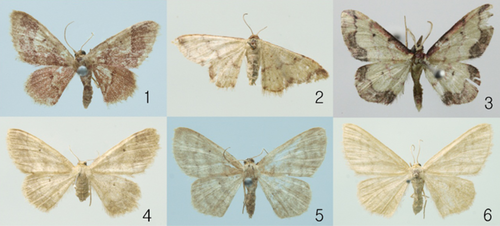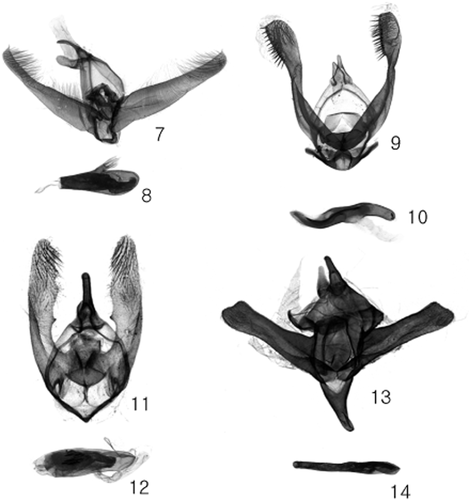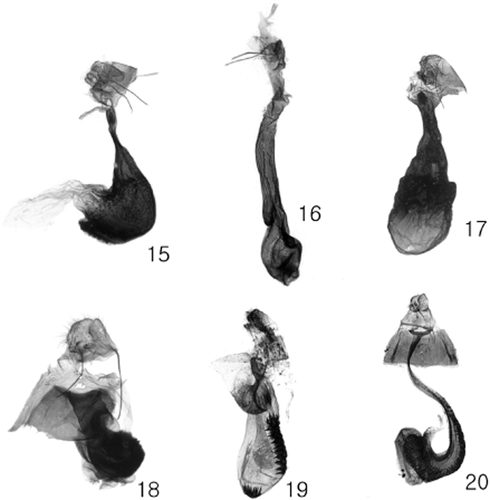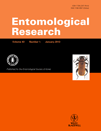Six new records of Idaea Treitschke (Lepidoptera: Geometridae, Sterrhinae) from Korea
Abstract
Six species of sterrhine genus Idaea Treitschke are reported for the first time from Korea: Idaea roseomarginaria (Inoue), I. paraula (Prout), I. sugillata (Bastelberger), I. imbecilla (Inoue), I. kyushuensis Sato, and I. nudaria (Christoph). To date, 23 species of Idaea have been reported from Korea. Diagnosis and descriptions of adults and photos of male and female genitalia are provided.
Introduction
The genus Idaea Treitschke includes about 680 species worldwide and is characterized by a comparatively narrow forewing with single areole, a similar wing pattern between fore- and hindwing, the hindwing usually without antemedial line and medial line at proximal position, male hindtibia without spurs and often dilated with sexual tufts, female hindtibia with two terminal spurs and male sternum A2 with horseshoe-shaped sclerite and single setose patch in its center (Hausmann 2004). The male genitalia of the genus can be characterized by simple and slender valva with a few setae or spine on apex, and the aedeagus with cornuti (Holloway 1997; Hausmann 2004). The female genitalia of the genus can be characterized by the well sclerotized and long ductus bursae and partly sclerotized corpus bursae filled with spines or spinules (Holloway 1997; Hausmann 2004).
Larvae of Idaea are usually polyphagous and detritus feeders (Covell 1983; Hausmann 2004). Species of Idaea are widely distributed across the world, but high species richness is observed in the Mediterranean, African savannah and the eremic belt of dry regions and semi-deserts in western Palearctic Asia (Hausmann 2004). The species richness of the genus Idaea is relatively low in East Asia, with 29, 21 and 16 species in Japan, the Russian Far East and Taiwan, respectively (Heppner & Inoue 1992; Viidalepp 1996; Kishida 2011).
Since Leech (1898) first reported eight species of Idaea from Busan and Wonsan, 17 species of Idaea have been reported in Korea (Oh 1995; Shin 1996). The purpose of this study is to report six newly recorded species of Idaea from Korea. Terminology of the morphological characteristics of adult morphology and genitalia follows Hausmann (2004). The material examined is now preserved in Mokpo National University, Jeonnam, Korea. Abbreviations used in this study are as follows: TL, Type locality; GW, Gangwon-do; GG, Gyunggi-do; CN, Chungcheongnam-do; GB, Gyungsangbuk-do; GN, Gyungsangnam-do; JN, Jeollanam-do; JJ, Jeju-do.
Taxonomy
Order Lepidoptera Linnaeus, 1758
Family Geometridae Stephens, 1829
Subfamily Sterrhinae Meyrick, 1892
Idaea Treitschke 1825: 446
Type species. Phalaena aversata Linnaeus, 1758
Idaea roseomarginaria (Inoue 1958) (Korean name: Gum-bul-gun-ae-gi-ja-na-bang) (Figs 1-6, 15-20)

Adults of Idaea in Korea. 1 I. roseomarginaria, 2 I. paraula, 3 I. sugillata, 4 I. imbecilla, 5 I. kyushuensis, 6 I. nudaria.
Sterrha roseomarginaria Inoue 1958: 244, pl. 34, fig. 5. TL: [Japan] Shizuoka Prefecture, Sakuma-cho, Noda.
Idaea roseomarginaria: Inoue 1982: 458.
Diagnosis
This species can be distinguished by the reddish ground color of fore and hindwings. The species is similar to I. sugillata in wing color, but can be distinguished by the thick reddish subterminal band of forewing and reddish hindwing. The female genitalia can be distinguished by the short slender ductus bursae and very large, pear-shaped corpus bursae with densely covered sclerite patches.
Description (Fig. 1)
Wingspan 15 mm. Antennae filiform; frons broad, covered with dark ochreous scales; labial palpi covered with light ochreous and whitish scales, short in length, almost equal to eye diameter, barely projected beyond frons. Body and legs covered with yellowish white hairs. Forewing: ground color yellowish white; basal part largely covered with reddish scales; central part costally yellowish white, dorsally reddish; subtermen reddish; termen yellowish white; underside with a discal dot and thick light brown medial and subterminal lines. Hindwing: ground color reddish; basal part partly yellowish white; fringe yellowish white; underside with a discal dot and light brownish subterminal line.
Male genitalia. Not examined.
Female genitalia (Fig. 15). Papillae anales rounded; apophyses posteriores long, almost two times the length of apophyses anteriores; antrum narrow, membranous; ductus bursae short, slender; corpus bursae very large, pear-shaped, inner wall densely covered with several sclerite patches.
Material examined
[JN] 1 female, Temple Baekyang-sa, JN: Jangsung-gun, 30.v.1996, HC Jeong.
Distribution
Korea (new record), Japan.
Idaea paraula (Prout 1914) (Korean name: Bul-gun-jul-ae-gi-ja-na-bang) (Figs 1-6, 15-20)
Ptychopoda paraula Prout 1914: 243. TL: [Taiwan] Alikang.
Idaea paraula: Heppner and Inoue 1992: 124.
Diagnosis
This species is similar to I. sugillata in wing pattern elements, but can be distinguished by the undulating postmedial line of forewing and narrow termen of hindwing. The female genitalia can be distinguished by the long, slender ductus bursae and small ovate corpus bursae filled with dense minute spinular signa.
Description (Fig. 2)
Wingspan 17 mm. Antennae filiform in female; vertex light yellowish; frons slender, covered with dark ochreous scales; labial palpi covered with dark ochreous scales, short in length, almost equal to eye diameter, barely projected beyond frons. Body and legs covered with brownish and yellowish white hairs. Forewing: ground color yellowish white, costally with dark pinkish scales; a relatively large dark reddish discal dot; transverse dark reddish postmedial line; dark reddish subterminal line; termen yellowish white; underside with thin light brown postmedial and subterminal lines. Hindwing: ground color yellowish white; dark reddish postmedial line; termen dark reddish; underside with light brownish postmedial line and reddish termen.
Male genitalia. Not examined.
Female genitalia (Fig. 16). Papillae anales rounded; apophyses posteriores long, almost three times of apophyses anteriores; antrum narrow; ductus bursae long, slender, sclerotized; corpus bursae small, ovate, filled with dense minute spines.
Material examined
[JN] 1 female, Is. Gageo-do (Soheuksan-do), JN: Shinan-gun, 28.vii.1974, KY Choi.
Distribution
Korea (new record), Taiwan.
Idaea sugillata (Bastelberger 1911) (Korean name: Bul-gun-tti-ae-gi-ja-na-bang) (Figs 1-6-15-20)

Male genitalia of Idaea in Korea. 7, 8 I. sugillata, 9,10 I. imbecilla, 11, 12 I. kyushuensis, 13, 14 I. nudaria.

Female genitalia of Idaea in Korea. 15 I. roseomarginaria, 16 I. paraula, 17 I. sugillata, 18 I. imbecilla, 19 I. kyushuensis, 20 I. nudaria.
Acidalia sugillata Bastelberger 1911: 23. TL: [Taiwan] Arizan.
Sterrha parallela Wileman and South 1917: 55. TL: [Taiwan] Arizan, 7300 ft; Rantaizan, 7500 ft.
Idaea sugillata: Heppner and Inoue 1992: 124.
Diagnosis
This species is similar to I. roseomarginaria in reddish wing ground color, but can be distinguished by the relatively larger wingspan, dark ochreous costa of forewing, the pinkish medial lines and reddish subtermen of forewing and the yellowish white hindwing with reddish termen. The male genitalia can be distinguished by the strongly tapered uncus, tongue-shaped gnathos with rounded apex, thick, sclerotized and ring-shaped transtilla and long, slender valva with a sharp pointed process at dorsodistal part. The female genitalia can be distinguished by the broad, membranous antrum, long ductus bursae with linear patch of spines and large, ovate, and posteriorly sclerotized corpus bursae.
Description (Fig. 3)
Wingspan 16–19 mm. Antennae bipectinate in male, filiform in female; vertex light yellowish; frons slender, covered with dark ochreous scales; labial palpi covered with light ochreous and whitish scales, short in length, almost equal to eye diameter, barely projected beyond frons. Body and legs covered with yellowish white hairs. Forewing: ground color yellowish white, costally with dark ochreous and pink scales; transverse pink antemedial and postmedial lines; a blackish discal dot; dark reddish subterminal line; termen yellowish white, dorsally tinged with dark reddish scales; underside with thin light brown postmedial and subterminal lines. Hindwing: ground color yellowish white; a black discal dot; dark reddish postmedial line; subtermen dark reddish; underside with light brownish postmedial line and reddish subtermen.
Male genitalia (Figs 7, 8). Uncus strongly tapered, moderate in length, almost equal to gnathos; gnathos tongue-shaped, apex rounded; tegumen triangular, long almost double length of vinculum; transtilla thick, sclerotized, ring-shaped; juxta narrow, membranous; saccus short, rounded at distal part. Valva long, slender, long hairs along ventral margin; cucullus with a sharp pointed process at dorsodistal part. Aedeagus long, rod-shaped; vesica long, tubular, one long spinular cornutus.
Female genitalia (Fig. 17). Papillae anales small, rounded; apophyses posteriores long, almost two times that of apophyses anteriores; antrum broad, membranous; ductus bursae long, broad with linear patch of spines; corpus bursae large, ovate, membranous, posteriorly sclerotized.
Materials examined
[GW] 1 male,1 female, Jindong-ri, GW: Inje-gun, N 37°58′ 45.07″ E 128°29.9′ 79″, 19.viii.2010, SS Kim; 1 male Bongmyung-ri, GW: Chuncheon, 31.vii.1992, KT Park, BK Byun.
Distribution
Korea (new record), Taiwan.
Idaea imbecilla (Inoue 1955) (Korean name: Got-eun-jul-ae-gi-ja-na-bang) (Figs 1-6-15-20 )
Sterrha imbecilla Inoue 1955: 75, pl. 6, fig. 1; pl. 7, fig. 1. TL: [Japan] Nagano Prefecture, Kamikochi.
Idaea imbecilla: Inoue 1982: 460.
Diagnosis
This species can be distinguished by the thick brownish subterminal line of fore and hindwings. This species is externally similar to I. kyushuensis, but can be distinguished by the relatively broad central part with a black discal dot and dark brownish subterminal lines of fore and hindwings. The male genitalia can be distinguished by the strongly tapered uncus, triangular gnathos with pointed apex, thick, sclerotized and n-shaped transtilla, long slender valva with expanded, hairy cucullus. The female genitalia can be distinguished by the broad sclerotized antrum, short broad ductus bursae and small ovate corpus bursae with a semi-rounded sclerite.
Description (Fig. 4)
Wingspan 15–17 mm. Antennae filiform; vertex light yellowish white; frons slender, covered with dark ochreous scales; labial palpi covered with dark ochreous scales, short in length, almost equal to eye diameter, projected beyond frons. Body and legs covered with yellowish white hairs; male hind tibia expanded with long yellowish white sexual tufts. Forewing: ground color light yellowish white; basal line light brown, slanted; a black discal dot; a weakly waved light brown medial line; subterminal line dark brownish, waved, parallel lines; termen slightly darker than other parts of forewing; underside light yellowish white with thick light brownish medial and subterminal lines. Hindwing: ground color light yellowish white; basal line light brownish, slanted; a black discal dot; subterminal line brownish, thick parallel lines; underside yellowish white with thick light brown medial and subterminal lines.
Male genitalia (Figs 9, 10). Uncus strongly tapered, moderate in length, almost equal to gnathos; gnathos triangular, apex pointed; tegumen triangular, long almost double length of vinculum; transtilla thick, sclerotized, n-shaped; juxta broad, sclerotized; saccus projected at dorsal part, roundly projected at distal part. Valva long, slender; cucullus expanded, hairy, dorsal margin with a line of spines. Aedeagus long, rod-shaped, medially bent; vesica long, tubular, one long spinular cornutus.
Female genitalia (Fig. 18). Papillae anales rounded; apophyses posteriores long, almost three times that of apophyses anteriores; antrum broad, sclerotized; ductus bursae short, broad; corpus bursae small, ovate, with a semi-rounded sclerite.
Materials examined
[GW] 1 female, Mt. Samak, 22.vi.1989, KT Park; 1 male, Ssangyong, 21.vi.1998; [GG] 1 male, Gwangneung, 4.ix.1981, GJ Won; 3 males, Is. Daebu, 29.vi.1997; [GB] 1 male, Naridong, Is. Ulreung, 24.vii.1998; [JN] 1 male, Mt. Duryun, 16.ix.1995; [JJ] 1 female, Bijarim, Is. Jeju, 3.x.2000.
Distribution
Korea (new record), Japan.
Idaea kyushuensis Sato 1994 (Korean name: San-ae-gi-ja-na-bang) (Figs 1-6-15-20)
Idaea kyushuensis Sato 1994: 58, figs 3, 4. TL: [Japan] Kumamoto Prefecture, Yabe-machi, Memaru, 700 m.
Diagnosis
This species is externally similar to I. imbecilla, but can be distinguished by the thin medial and subterminal lines of fore and hindwings. The male genitalia can be distinguished by the digitiform uncus, triangular gnathos with pointed apex, long slender valva with wave like costal projections and long spinular hairy cucullus. The female genitalia can be distinguished by the narrow antrum, long sclerotized ductus bursae, long ovate corpus bursae with a long spinular signa patch and a short spinular patch.
Description (Fig. 5)
Wingspan 15–16 mm. Antennae filiform; vertex light yellowish white; frons slender, covered with dark ochreous scales; labial palpi covered with dark ochreous scales, short in length, almost equal to eye diameter, projected beyond frons. Body and legs covered with yellowish white hairs; male hind tibia expanded with long yellowish white sexual tufts. Forewing: ground color light yellowish white; basal line light brown, slanted; a black discal dot; weakly waved light brown medial lines; subterminal line light brown, weakly waved; underside light yellowish white with light brown medial and subterminal lines. Hindwing: ground color light yellowish white; basal line light brownish, slanted; medial lines light brownish, weakly waved; subterminal line light brown, weakly waved; underside yellowish white with light brown basal, medial and subterminal lines.
Male genitalia (Figs 11, 12). Uncus digitiform, moderate in length, about 1.5 times that of gnathos; gnathos triangular, apex pointed; tegumen triangular, short almost equal length of vinculum; transtilla broad; juxta V-shaped, sclerotized; saccus strongly projected at distal part. Valva long, slender; costa dorsally wave like projections; cucullus hairy with long spines. Aedeagus long, rod-shaped; vesica with 5–6 spinular cornuti.
Female genitalia (Fig. 19). Papillae anales rounded; apophyses posteriors long, almost twice of apophyses anteriores; antrum narrow; ductus bursae long, sclerotized; corpus bursae long, ovate, with a long spinular signa patch and a short spinular patch.
Materials examined
[GW] 1 female, Poongjeon-dong, Buk-myon, Inje-gun, 22.vii.2008; 1 male, Mt. Garisan, Hongcheon, 3.viii.1995; 1 female, Garak-jae, Hongcheon, 9.vii.1995; 1 male, Mt. Kyebang, 21.vii.1995; [GG] 1 male, Mt. Cheongkye, Gwacheon,11.v.1997; 1 female, Dongducheon-si, 29.vii.1997, JC Sohn; 1 female, Mt. Myungji,7.viii.2001; [CN] 1 female, Gapsa, Mt. Gyeryong, 5.viii.2011; [GN] 1 male, Mt. Gaya, 6.viii.2008.
Distribution
Korea (new record), Japan.
Idaea nudaria (Christoph 1881) (Korean name: Sil-jul-no-rang-ae-gi-ja-na-bang) (Figs 1-6-15-20)
Acidalia nudaria Christoph 1881: 44. TL: [Russia] Amur, Chingan Mts.
Acidalia nudaria infuscaria Leech 1898: 101. TL: [Japan] Yesso; China: Ningpo, Chang-yang.
Idaea nudaria: Inoue 1982: 458.
Diagnosis
This species is characterized by the light yellowish white wings with light brownish parallel postmedial and subterminal lines on forewing and light brownish medial lines on hindwing. The male and female genitalia examination can confirm the species identification. The male genitalia can be distinguished by long tapered gnathos, thick, bridge-shaped transtilla, long tapered saccus, long slender valva with slanted edge and long aedeagus with a long spinular cornutus on the vesica. The female genitalia can be distinguished by broad and shallow antrum, long curved ductus bursae with spines from anterior part to middle and small ovate corpus bursae.
Description (Fig. 6)
Wingspan 19–22 mm. Antennae fasciculate in male, filiform in female; vertex light yellow; frons broad, covered with dark ochreous scales; labial palpi covered with dark ochreous scales, short in length, less than eye diameter, barely projected beyond frons. Body and legs covered with yellowish white hairs; male hind tibia with long yellowish white sexual tufts. Forewing: ground color light yellowish white; medial lines light brown, waved; subterminal line light brown; termen slightly darker than other parts of forewing; underside light blackish with yellowish white postmedial and subterminal lines. Hindwing: ground color light yellowish white; antemedial, postmedial and subterminal lines light brownish and weakly waved; underside yellowish white with light brown medial and subterminal lines.
Male genitalia (Figs 13, 14). Uncus digitifirm; gnathos strongly tapered, basally bent; tegumen triangular, moderate almost equal length of vinculum; transtilla thick, sclerotized, n-shaped; juxta broad, sclerotized; saccus medially strongly projected. Valva long, slender; costa triangular, sclerotized; sacculus triangular, sclerotized; cucullus slanted, hairy. Aedeagus long, tube-shaped; vesica long, tubular, one large spinular cornutus.
Female genitalia (Fig. 20). Papillae anales rounded; apophyses posteriores long, almost three times that of apophyses anteriores; antrum broad, shallow, sclerotized; ductus bursae long, curved, sclerotized at posterior part, densely speculate at middle and anterior parts; corpus bursae small, ovate, membranous without a signum.
Materials examined
[GW] 1 female, Ssangyong, 21.vi.1998; [GG] Mt. Jugeum, 1 female, 8.viii.1993, 1 male, 18.vi.1994, 1 male, 6.vi.1998; Mt. Gumdan, 1 female, 27.vi.1995, 2 females, 14.vi.1998; 2 females, Mt. Goryung, 25.vi.1995; 1 female, Mt. Mani, Is. Gangwha, 20.vi.1997, MG Paek.
Distribution
Korea (new record), Japan, China, Russia (Far East).
Acknowledgments
We thank Dr Kyu-Tek Park, Dr Bong-Kyu Byun, Dr Heon-Cheon Jeong, Dr Mun-ki Paek and Mr Jae-Cheon Sohn for providing materials for this study. We also thank Miss Jin Lee for photographing the genitalia. This study was supported by the project on the survey and excavation of Korean indigenous species of the National Institute of Biological Resources (NIBR) under the Ministry of Environment, Korea.




